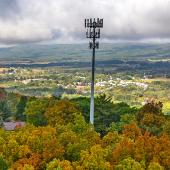This blog is a repost from IWCE’s Urgent Communications, originally published on January 17, 2024.
This blog post is part of the "Tech Talk" series focused on the First Responder Network Authority’s (FirstNet Authority) standards development activities to support public safety. This post recaps discussions linked to public safety and other related topics from the 3GPP Plenary meetings that were conducted in December 2023. The FirstNet Authority represented public safety interests at the Plenary meetings.
The 3GPP Plenary meetings took place Dec. 11-15, 2023, in Edinburgh, Scotland. Participants made continued progress on Release 18 (R18) features of interest to public safety. The Plenary meetings also included planning for Release 19 (R19) features, and the start of preliminary discussions for Release 20 (R20).
The FirstNet Authority served as an active participant in R18 progress and R19 planning activities, acting as a driving force for inclusion of a New Radio (NR, a.k.a. 5G) Sidelink (SL) multi-hop relaying feature for R19 to extend off-network wireless coverage for public safety. This feature requires work in multiple 3GPP Technical Specification Groups (TSGs) and will be further discussed in the sections below. The planned December 2025 completion date for R19 remains on track.
During the Plenary meetings, a joint meeting was held among the 3GPP TSGs to start looking at “high-level considerations for 6G.”
The Radio Access Network (RAN) TSG Plenary
There were more than 425 in-person attendees at the TSG RAN Plenary meeting. RAN is responsible for defining the requirements, functions, and interfaces of the 3GPP radio network.
The RAN working groups reported completion of all core work related to the R18 features relevant to public safety. The completed features include NR SL evolution, expanded and improved NR positioning, enhanced support of reduced-capability (RedCap) NR devices, NR Network-controlled Repeaters (NCR), and NR support for Uncrewed Aerial Vehicles (UAVs). NR non-terrestrial network (NTN) or satellite work, with objectives including network-verified user equipment (UE, a.k.a, mobile device) location, is near completion.
The working groups reported that the specifications are now complete for the support of a FirstNet-led High Power User Equipment (HPUE) Power Class 2 LTE Frequency Division Duplex Single Band 14 in R18. As reported in our last article, while the Power Class 2 is a slightly lower power than the Power Class 1 HPUE that was approved previously, it will have a device form factor for use as a hotspot router and may possibly be used as a regular UE.
During R19 planning, the FirstNet Authority submitted a paper advocating for the inclusion of a NR Sidelink multi-hop UE to Network relaying (MU2N) feature. Thirty-five member companies co-signed the paper with the FirstNet Authority, including major vendors, operators, and international government public safety agencies.
The MU2N feature will be included in the TSG RAN R19 work package and will require additional specification development from the TSG Service and System Aspects working groups.
Multi-hop relay communication is a technique to extend network coverage. The FirstNet Authority previously helped drive a single-hop relay feature in the R18 work package to allow for communication in low and/or out-of-coverage scenarios. As an example, this feature would support an out-of-coverage UE to connect to a UE which is in-coverage, and to communicate with anyone on a wireless or wireline network.
The new R19 MU2N feature is targeted to add two additional relays between the remote UE and the network relay UE defined in R18. The R19 multi-hop relay feature will provide additional coverage over the R18 single-hop relay feature for off-network scenarios connecting back to the network. We expect future 3GPP releases will add additional relay hops to this feature.
The RAN Plenary discussed and endorsed several new features including evolution of satellite (NTN) for NR; evolution of NTN for IoT; and additional topological enhancements. These topological enhancements include further improvements for wireless access backhaul, 5G Femto cell, and Vehicle Mounted Relay. 5G Femto offers a cost-effective way to improve 5G indoor coverage and enables better support for enterprise mobility.
The functional freeze date for R19 work in TSG RAN is currently scheduled for September 2025, and the final completion date is planned for December 2025.
The Service and System Aspects (SA) TSG Plenary
More than 330 in-person attendees were at the TSG SA Plenary meeting. TSG SA is responsible for the overall architecture and service capabilities of 3GPP-based systems.
The group reported on R18 activities and work previously approved for inclusion in R19. Considerable time was spent planning and discussing additional R19 study items. The plenary also discussed the R20 timeline.
Since the last plenary meeting in September, many of the TSG SA working groups reported that their work mainly focused on change requests for maintenance and alignment with other working groups for completed R18 architecture specifications. Some groups also reported that work has started on previously agreed R19 features.
The working group responsible for 5G Security Aspects continues to focus on enabling the 5G system to support use of cryptographic algorithms with 256-bit key sizes to provide enhanced security. Most recently, work has started to document these 256-bit algorithms in 3GPP series technical specifications. This work is the first step to ensure 256-bit algorithms are ready when it is appropriate for the 5G system to support their use.
The working group focusing on mission-critical (MC) features reported continued progress on several R19 features that were agreed upon during the September Plenary meeting. High-priority items for public safety reported 20%-40% completion. These features include enhancements for mission critical; phase 3 of uncrewed aircraft systems; sharing of administrative configurations between interconnected mission critical service systems; and a study on enhanced application-layer support for location services.
As discussed in previous blogs, the SA Requirements working group typically works one release ahead of the other 3GPP working groups. This group reported the completion of requirements of all topics of interest to public safety in R19.
These included the study phase on integrated sensing and communications and 5G satellite enhancements. Integrated sensing uses 5G radio waves—much like radar—to sense the position and shape of object, which is designed to increase the situational awareness of first responders.
The TSG SA Plenary meeting spent considerable time planning for R19 features. The plenary agreed to include new study items for R19. Several approved study items require coordination between the RAN and SA working groups.
The most significant study item of interest to the FirstNet Authority and public safety was the system enhancement for Proximity Services (ProSe) also known as UE-to-UE direct communications. The work in this study will focus on MU2N and multi-hop UE-to-UE relay (MU2U) features.
The FirstNet Authority led the effort to secure 25 supporting companies to demonstrate the need for these capabilities. As discussed in the RAN section above, the MU2N feature requires work in both the RAN and SA working groups.
Also, the MU2U feature will let UEs that are in weak or out-of-network coverage areas to communicate with each other with the help of intermediate UEs acting as relays to extend the coverage. This multi-hop feature will further extend range for first responder communications.
Public safety may benefit from additional study items approved during the meeting that include enhancements to the vehicle mounted relay to include backhaul support over NTN, Femto-cell enhancements; ambient IoT, artificial intelligence and machine learning; and a phase 3 for UAVs that will be designed to improve detection and avoidance capabilities, as well as improved communications.
As the SA Requirements group begins to plan for 6G in R20, they agreed to plan for an International Mobile Telecommunications (IMT)-2030 workshop in May 2024 to begin looking at the work underway by the various 3GPP market representative partners (MRPs) and other global organizations interested in 6G. This workshop will allow presentations only from partners and not individual 3GPP members.
Finally, the TSG SA Plenary discussions and the following joint session with the RAN and CT Plenary groups continued discussing 6G standardization efforts. 3GPP will begin 6G study items in R20, and technical specifications will begin in R21.
3GPP is expected to hold a TSG-wide 6G workshop in March 2025. Release 21 is expected to produce the first set of 3GPP 6G technical specifications, including the release for IMT-2030 submission, before 2030. 3GPP plans to have more detailed 6G timeline decisions at the upcoming March Plenary meetings.
The Core Network and Terminals (CT) TSG Plenary
There were more than 200 in-person attendees at the TSG CT Plenary meeting. The CT TSG covers the protocol details that follow the requirements and architectural work performed in the SA TSG.
The CT plenary concentrated on advancing R18 and continues to show solid progress for all aspects of the stage 3 protocol work. CT has several mission-critical features in progress, including MC over 5G multicast-broadcast (100% completed), MC protocol enhancements (60% completed), and ProSe phase 2 (95% completed).
Work recently began on MC gateway UE (20%), and enhancements to MCPTT features (60%) should be completed by March 2024. CT working groups will not start R19 work until most of the other SA working groups complete their R19 architecture technical specifications.
Further information on the 3GPP’s work and organization can be found at: www.3gpp.org.
Dean Prochaska is the FirstNet Authority’s senior director of standards. FirstNet Authority Senior Standards Engineers Jeff Cichonski, Ihab Guirguis, Satish Jha, Mark Lipford and Eshwar Pittampalli contributed to this article.




















